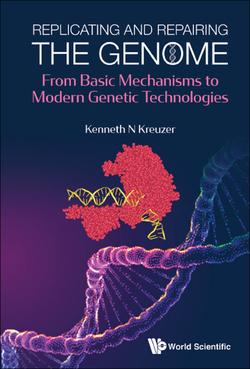Читать книгу Replicating And Repairing The Genome: From Basic Mechanisms To Modern Genetic Technologies - Kenneth N Kreuzer - Страница 31
На сайте Литреса книга снята с продажи.
3.2The replicative DNA polymerase holoenzyme
ОглавлениеTwo different DNA polymerases are involved in E. coli DNA replication. For historical reasons, the main replicative polymerase for both leading- and lagging-strand synthesis is called DNA polymerase III, while the polymerase involved in processing Okazaki fragments is DNA polymerase I. DNA polymerase III can be isolated as a multi-protein complex called the “holoenzyme,” and the composition of the holoenzyme reveals much about the overall replisome (Figure 3.1A, right). The complex contains two copies of the actual DNA polymerase, which is a three-subunit enzyme that is referred to as the DNA polymerase III “core” (Figure 3.1A, left). In the context of chromosomal replication, one of these core enzymes replicates the leading strand and the other replicates the lagging strand.1 The holoenzyme also contains one copy of a multi-subunit complex that can load sliding clamps on the DNA, not surprisingly called the “clamp loader.” As we will see below, repetitive clamp loading is a central feature of lagging-strand replication. The holoenzyme also contains the sliding clamp, along with two other subunits that play roles in the overall architecture of the complex.
Figure 3.1. The Escherichia coli replicative DNA polymerase. The three-subunit core of the bacterial replicative polymerase (panel A, left) has active sites for polymerase and exonuclease activity (in separate subunits; the open mouths), and a structural subunit (the hat). The complete DNA polymerase complex, called holoenzyme, is diagrammed at the right of panel A and consists of two copies of the core polymerase along with clamp (panel B) and clamp loader (panel C). The sliding clamp is a ring-shaped protein consisting of two identical subunits (red and blue in panel B), each of which has three similar subdomains. The image of the crystal structure of the clamp shown at the left of panel B is from the RCSB PDB (www.rcsb.org) of PDB ID 2POL (Kong et al., 1992). The C-terminal face of the clamp, which binds both clamp loader and DNA polymerase core, is facing up in the cartoon diagram on the right of panel B. The clamp loader (panel C) consists of five subunits derived from three different genes, as described in the text. Two of the subunits, the ones with the extended arms, bind to the core of the DNA polymerase in the holoenzyme. The clamp-loading pathway is diagrammed in panel D. Parts of this figure were modified from Kelch et al. (2012).
The subunits of the holoenzyme are named after letters of the Greek alphabet. Detailed discussions of the roles of every subunit are beyond the scope of this chapter, but for those who engage the literature further, the names of the subunits are as follows: polymerase III core is composed of α, ε, and θ; the clamp loader is composed of τ, γ, δ, and δ′, and is also called the γ complex; the clamp is called β, and the architectural proteins are χ and ψ.
The three-subunit polymerase III core complex that replicates both the leading and lagging strand has separate subunits with DNA polymerase and proofreading exonuclease activity (unlike the combined activities within the major subunit of the bacteriophage T7 DNA polymerase). When misincorporation occurs during DNA synthesis by polymerase III core, the growing DNA chain with the errant nucleotide residue is therefore passed between the two protein subunits to excise the incorrect base and then back to the polymerase subunit to resume DNA synthesis. The third subunit of the polymerase core plays a structural role and assists the proofreading subunit, and in some bacterial species, this subunit is missing.
